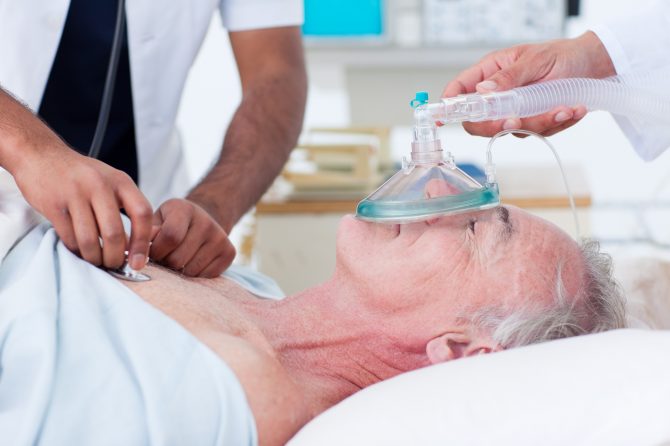
CPR Using Chest Compressions Alone Effective
Performing only chest compressions to help keep the blood flowing during a heart attack can be as effective as standard cardiopulmonary resuscitation, or CPR, that includes mouth-to-mouth breathing, says a new study.
If a person has not been well-trained in CPR and sees someone having what appears to be a heart attack, it is okay to only use only chest compressions.
Two new studies, appearing in the New England Journal of Medicine, found that when bystanders were instructed by emergency dispatchers to give either standard CPR or chest-compression-only CPR, survival rates were similar between the two techniques.
Experts hope that by making the procedure easier and removing the mouth-to-mouth contact that more bystanders might be willing to attempt CPR.
“Bystander CPR can double your chances of survival, but the biggest thing is getting more people to try it,” explains the lead author of one of the studies, Dr. Thomas Rea, medical director of the Emergency Medical Services Division of Public Health for Seattle and King County in Washington.
“Only one in three people who need it get bystander CPR,” says Dr. Rea. “If we can make it less complicated, it may enable more people to perform CPR.”
Start with Compression, Others Can Bring Defibrillator
Rescue breathing can be difficult, especially for someone who is not trained in the technique, says Dr. Rea. Even in people who are trained, but do not often have the chance to practice rescue breathing, it can be hard to do.
Dr. Dana Peres Edelson, director of clinical research at the emergency resuscitation center at the University of Chicago Medical Center, says, “Even for myself as a physician, because I don’t do mouth-to-mouth on a regular basis, it’s hard to do.”
Dr. Edelson says that when you see a seemingly healthy adult suddenly drop, call 911 and then begin chest compressions. Emergency dispatchers can provide instructions on where to place your hands.
If someone else is available to help, she says to have them call 911 and to go look for an automatic external defibrillator (AED). AEDs are now present in many public places, such as malls, schools, and stadiums.
“Push hard, push fast, and don’t stop unless you have to give a breath or use a defibrillator,” says Dr. Edelson. “If you do stop, keep the pause as brief as possible.”
Two Studies Show Similar Results
Dr. Rea and his colleagues studied dispatcher-assisted bystander CPR. Adults who needed CPR were assigned to receive either traditional CPR or chest-compression-only CPR.
The second study was similarly designed, but conducted in Sweden. Both groups of researchers concluded that compression-only CPR with instructions from emergency dispatchers was likely to be as effective as traditional CPR, possibly even slightly more so.
The findings do not apply to emergency workers and others who are well-trained in CPR, says Dr. Rea.
There are some times when rescue breathing is necessary. Dr. Edelson says that it is recommended that children generally receive rescue breathing, as well as anyone who was choking or looked like they were having trouble breathing before they became unconscious.
But, she notes, that lay people might not be able to discern who needs rescue breathing or not, so she advises, “If you haven’t been trained in CPR, just start doing chest compressions as fast as you possibly can.”
Dr. Rea agrees. “You can make a life-and-death difference by providing chest compressions. You don’t have to be perfect; all you can do is provide benefit. Your actions can save a life.”
Always consult your physician or other healthcare provider for more information.
More about CPR
Cardiopulmonary resuscitation, or CPR, is administered when someone’s breathing or pulse stops. If both have stopped, then sudden death has occurred. While some of the causes of sudden death include poisoning, drowning, choking, suffocation, electrocution, or smoke inhalation, the most common cause is from heart attack.
The following are the most common symptoms of a heart attack:
- severe pressure, fullness, squeezing, pain and/or discomfort in the center of the chest that lasts for more than a few minutes
- pain or discomfort that spreads to the shoulders, neck, arms, or jaw
- chest pain that increases in intensity
- chest pain that is not relieved by rest or by taking cardiac prescription medication
- chest pain that occurs with any/all of the following (additional) symptoms of a heart attack:
- sweating, cool, clammy skin, and/or paleness
- shortness of breath
- nausea or vomiting
- dizziness or fainting
- unexplained weakness or fatigue
- rapid or irregular pulse
Although chest pain is the key warning sign of a heart attack, it may be confused with indigestion, pleurisy, pneumonia, or other disorders. It is important to note that not all of these symptoms are present in every heart attack.
If you or someone you know exhibits any of the above warning signs, act immediately. Call 911, or your local emergency number. If necessary, give CPR if you are trained, or ask someone who is. CPR certification means you have received the necessary training and practice and can comfortably perform this lifesaving technique. More than five million people each year receive training.
Both the American Red Cross and the American Heart Association (AHA) provide excellent training programs in CPR, which helps to save thousands of lives each year. Ask your physician or healthcare provider for more information on becoming trained in CPR.
With an increasing fear of disease among the public, some people may be reluctant to perform the mouth-to-mouth resuscitation portion of CPR. The AHA is now recommending that 911 emergency dispatchers be trained to instruct reluctant bystanders in the compression-only CPR that involves no mouth contact.
Always consult your physician for more information.
Online Resources
(Our Organization is not responsible for the content of Internet sites.)
National Heart, Lung, and Blood Institute (NHLBI)
New England Journal of Medicine – CPR with Chest Compression Alone or with Rescue Breathing

Leave a reply